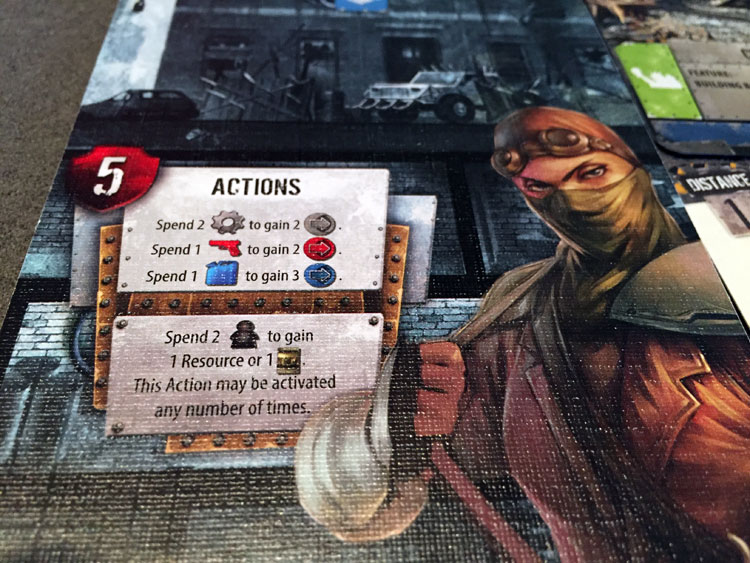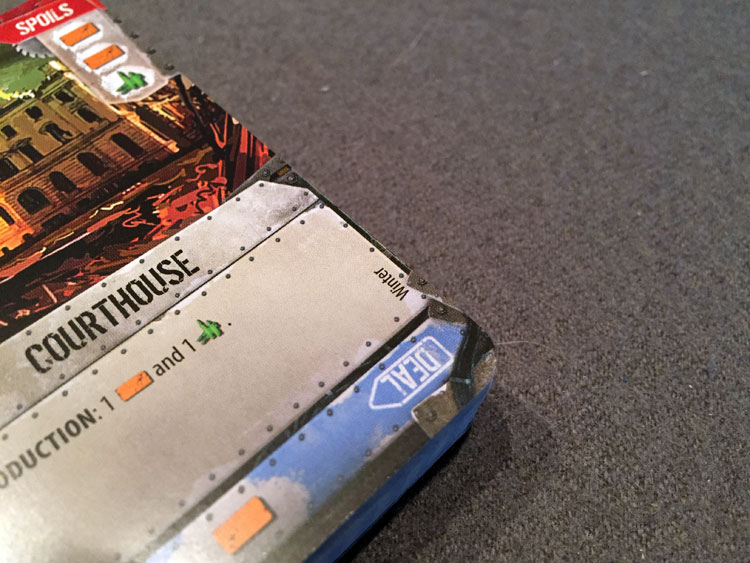 One of the very first products Portal Games published was the Neuroshima RPG. While this pen and paper role playing game is no longer in print, it did create a world for many of Portal Games current titles to live in. From the amazing Neuroshima Hex board game, to asymmetrical card games likes Neuroshima: Convoy, there are quite a few options for spending some time in this post-apocalyptic world.
One of the very first products Portal Games published was the Neuroshima RPG. While this pen and paper role playing game is no longer in print, it did create a world for many of Portal Games current titles to live in. From the amazing Neuroshima Hex board game, to asymmetrical card games likes Neuroshima: Convoy, there are quite a few options for spending some time in this post-apocalyptic world.
Today, we are going to be looking at the 51st State Master Set, that takes place in the Neuroshima Universe. 51 State was a card game published in the earlier days of Portal Games. The 51st State Master Set not only updates the look and components of the game, but also revises the rules for smoother game play. Was this luxury treatment worth the effort? Time to find out!
51st State is an engine building card game for 2-4 players that takes about 60 minutes to play. 51st State plays best with 2-3 players.
Game Overview:
In 51st State, players take control of one of the game’s four factions in an attempt to rebuild the country with their own faction in power. During the game, player’s will be building out their tableau by constructing buildings, hiring leaders, making deals, and razing things to the ground.
Each card in 51st State can be used in a variety of ways: You can raze it to get many resources at once, you can make a deal to get one resource each turn, or you can build it to gain access to its special ability. How and where you play your cards will determine your success in the game.
In 51st State, it’s a race to 25 victory points. Once a player hits that mark, the endgame is triggered. When the points are added up, the player with the most victory points is the winner.
Game Components:

The 51st State Master Set is substantial upgrade over the original edition of 51st State. The game contains all new (and much improved) artwork, along with more thematically redesigned cards. I’m definitely a fan of the new look of the Master Set.
The game comes with 200 cards in 4 different decks: Base Game, Connection Cards, New Era Expansion, and Winter Expansion. Usually you will just play with one expansion at a time, unless you want to get crazy.
In addition to the cards, the game comes with four different factions, each of which has only some minor differences in their faction abilities. In the usual Portal Games style, the faction boards are dual sided with a male or female avatar on either side.
The Master Set also comes with a pile of custom tokens, both wooden and cardboard. The wooden resource tokens look great and have a unique shape to represent what they are: Brick, Gun, Fuel, and Iron. Hurray for no wooden cubes!
Finally, the rulebook is revised both in rules and quality from the original edition. If you ever tried to play the original 51st State, you know that the rulebook can best be described as…awful. And that’s probably being generous. Thankfully, the rulebook in the Master Set is very well done and made learning the game breeze. There is also a “what’s changed” guide to help players from the original edition get up to speed quickly with this new version.
How to Play:
In 51st State, players are racing to be the first to 25 victory points. To setup the game, each player takes a faction board and a hand of cards. If you are playing with one of the included expansions, those cards are shuffled in with the base game cards into a shared, common deck.
51st State is played over a series of rounds, with each round having 4 phases:
1. Draft: Draw a number of cards equal to the number of players +1. Each player, from the start player clockwise, selects a card. This process is then repeated except the cards are chosen in the reverse order.
2. Production: Players collect resources and distance tokens based on what is produced in their tableau. Players will gain resources from their faction board, deals, and production buildings in their play area.

3. Actions: Starting with the start player and going clockwise, each player takes one action at a time until everyone has passed. Different actions include:
- Build a location: Play a card from your hand into your faction area. You must pay grey distance tokens equal to the location’s distance. All distances are either 1, 2, or 3. Alternatively, you can “develop” a card to a new one by paying one brick.
- Make a deal: Play a card from your hand into your deal area. You must pay blue distance tokens equal to the locations distance.
- Raze a Location: Race a location from your hand by paying red distance tokens equal to its distance value. Alternatively, you can raze an opponent’s building in their play area by paying red tokens equal to the defensive value. In either case you immediately receive the resources in the raze field on the card.
- Use an action on a card or faction board: Unless otherwise stated, each action can only be used once a round.
- Use another player’s open production: If a player has an open production location free, you can send a worker there to collect the resource it provides. The owning player gains a worker from the supply as a bonus.
- Take a connection card: Connection cards will grant you blue or red distance tokens to be used on a later turn.
- Pass: Once you pass, you are finished for the round. You also can no longer be attacked and your open production locations cannot be used.
4. Cleanup: Any leftover goods not on a storage building are discarded. Any resources or meeples on your action buildings are returned to the supply. The first player token is passed.
Rounds will continue in this manner until one player has 25 victory points. The round is finished and each player gains additional victory points equal to the number of buildings in their tableau. The player with the most points is the winner.

Game Experience:
51st State checked a lot of boxes of the list of what makes me enjoy a card game. Has a great theme? Check. There are mutli-use cards? Check. Has fantastic production quality? Check. Quick playing turns? Check. So it’s no surprise that I really enjoyed this game.
As a general rule, we try to avoid spending too much time comparing one game to another in a review. We feel like a game should stand on its own, even if it pulls mechanics from another game. That being said, fans of Imperial Settlers will definitely see some similarities between the two games. However, even though they share some mechanics, 51st States doesn’t just feel like a re-theme of Imperial Settlers. In fact, Portal Games has a list of the differences between the two. I’ll leave it up to you to decide if you need both in your collection.
Moving on, I quite enjoyed the engine building aspect of 51st State. What’s interesting is that you will be doing a lot of converting in this card game. Playing cards, be them buildings, deals, or razing, requires distance tokens. However, most production cards provide resources, not distance tokens. This means that you will need to setup an engine to start converting those resources into distance tokens.

The easiest way to do that is with your faction board action. This will usually let you convert one resource into 1 or 2 distance tokens. Each faction’s ratio is just a little bit different. This means you should definitely choose the faction that aligns with how you like to play the game.
Unfortunately, that’s about the only difference between the factions. So while that means everyone is on more even footing in the game, it does take away a bit of variety. Whether I’m playing the Merchant’s Guild or the Mutant’s Union, they don’t feel that different from each other. I wish designer Ignacy Trzewiczek had given us a bit more uniqueness in the factions.
One rule I really enjoyed in 51st State was the upgrade mechanic. You can pay a brick resource to and dump one of your existing buildings and replace it with another one (earning a victory point in the process). This creates some interesting situations where you can get out a hard to purchase distance 3 building out in round one or two. In a game where getting building distance tokens can be hard, this can really give you a boost.

The Master Set also comes with two expansions, Winter and New Era. The Winter expansion seems to be more for people who enjoy constructing buildings, while New Era is for those groups that like confrontation. While I love that both the expansions are included in the Master Set, playing with them does make teardown a bit of a pain. Since you aren’t supposed to mix both expansions in at once, you have to pull the expansion cards back out at the end of the game. Unfortunately, the only way to identify an expansion card is with some tiny text on the bottom of the card. I would have preferred an icon or something less subtle to help find them easier.
Finally, let’s talk player scaling. 51st State pays great with two players and even three. Turns will go by quickly and you will have access to a decent amount of open production locations. When you get up to 4 players, however, the game can take a little long. As there isn’t much to do when it’s not your turn, the downtime is longer than I’d like. It’s not unbearable, but the game definitely flows better with less players. That being said, the game plays fine at 4, but 2-3 is definitely my favorite. I don’t think I’m losing much by playing it at the lower player count.
Final Thoughts:

The 51st State Master Set is a clear upgrade over the old edition. I had played the original 51st State and enjoy the master set much more. I much prefer the streamlined game play over the more convoluted rules of the first edition. Plus, the redesigned components, artwork, and cards are night and day better than the first edition.
The multi-use cards in the 51st State Master Set have a lot of variety and the two included expansions help the games replay value immensely. Overall I had a lot of fun with 51st State and really enjoyed the engine building nature of the game. Other than some minor nitpicks, such as the teardown when playing with an expansion or wishing for more variety in the factions, I think the 51st State Master Set is a great game.
If you’d like to get a copy of the 51st State Master Set, you can pick it up for about $60.
Final Score: 4 Stars – A fun engine building game with a great post-apocalyptic theme. The Master Set’s new rules and components make it a must own for fans of the game.
 Hits:
Hits:
• Great artwork and components
• Well done rulebook
• High replay value with 2 included expansions
• Multi-use cards add variety to the game play
Misses:
• Downtime a bit much in a four player game
• Wish there was more variety between the factions
• Teardown could be easier






















